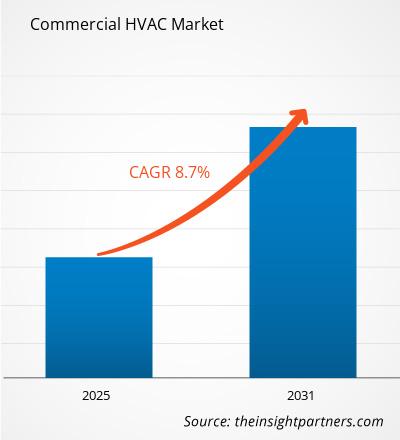2024 年商用暖通空调 (HVAC) 市场规模为 793 亿美元,预计到 2031 年将达到 1364.4 亿美元;预计 2025 年至 2031 年的复合年增长率为 8.2%。对智能暖通空调系统日益增长的需求以及对暖通空调即服务 (HVAC as a service) 的需求不断增长,可能仍将是主要的市场趋势。
商用暖通空调市场分析
商用暖通空调系统通常比住宅暖通空调系统大得多。较大的建筑物需要更多的电力才能充分供暖、制冷和通风,而且商业建筑通常比住宅大得多。商用暖通空调系统通常更复杂,因为它们体积更大、功率要求更高。商业建筑中的暖通空调需求也可能更复杂,因为建筑的不同部分可能需要不同的温度和通风。商用暖通空调系统也由一个封装单元组成,所有设备都安装在一个机柜中。这样,整个装置就可以根据需要移动或改造,以适应不断变化的业务条件。此外,它们根据大型建筑的特殊要求进行设计,确保较高的室内空气质量、能源效率和居住舒适度。
商用暖通空调市场概览
全球商业建筑项目数量的增长是推动商用暖通空调市场增长的主要因素之一。世界各国都有不同的商业建筑项目,例如办公楼、机场和商场。例如,2024 年第四季度,N3-5 项目开工建设。该项目涉及在日本建造一座 13 层的办公楼。该项目预计将于 2026 年第四季度竣工。此外,根据哥白尼观测数据,2024 年是自 1850 年以来全球气温记录中最热的一年。因此,全球气温和天气状况的上升正在增加对暖通空调系统的需求。此外,各国政府出台的严格法律法规,特别是有关制冷剂使用的法律法规,也推动了对环保和智能 HVAC 系统的需求。
自定义此报告以满足您的要求
您将免费获得任何报告的定制,包括本报告的部分内容,或国家级分析、Excel 数据包,以及为初创企业和大学提供超值优惠和折扣
商业暖通空调市场: 战略洞察

- 获取本报告的主要市场趋势。这个免费样本将包括数据分析,从市场趋势到估计和预测。
您将免费获得任何报告的定制,包括本报告的部分内容,或国家级分析、Excel 数据包,以及为初创企业和大学提供超值优惠和折扣
商业暖通空调市场: 战略洞察

- 获取本报告的主要市场趋势。这个免费样本将包括数据分析,从市场趋势到估计和预测。
商用暖通空调市场驱动因素和机遇
气温升高和不可预测的天气模式
全球气温持续上升。根据哥白尼观测数据,2024 年是自 1850 年以来有多个数据集记录的全球气温中最热的一年。2024 年,全球平均气温为 15.10°C,比 2023 年的前最高年度记录高出 0.12°C。2024 年也比 1991 年至 2020 年的平均气温高出 0.72°C,比工业化前水平高出 1.60°C,是历年气温首次超过该水平 1.5°C。过去十年是有记录以来最温暖的十年。2024年1月至6月,每个月的气温都高于上一年同期。2024年8月的气温与2023年8月的创纪录气温持平,而随后的7月至12月,都是同期第二温暖的月份,仅次于2023年的同期月份。此外,2024年7月22日,全球日平均气温创下17.16摄氏度的新高。
随着气候变化导致全球气温上升,企业的制冷需求也在增加。这一趋势在城市地区尤为明显,因为城市热岛效应加剧了气温上升。商业建筑越来越需要更强大的暖通空调系统来维持舒适的室内环境,从而导致对节能解决方案的需求增加。智能暖通空调解决方案能够根据实时温度数据优化性能,对于降低能源成本和提高舒适度至关重要。因此,不断上升的气温和不可预测的天气条件正推动商用暖通空调 (HVAC) 市场采用更现代、更高效、适应性更强的解决方案。建筑业主和管理者越来越认识到暖通空调系统的需求,该系统不仅要提供可靠的舒适度,还要满足可持续性和监管标准。
新兴的改造市场
改造是指更新和修改现有气候控制系统,使其运行更高效、环境影响更低的过程。这可能包括更换过时的组件、采用新技术以及优化系统以提高性能。节能效果的百分比取决于许多方面,包括组件的类型。根据美国能源部的研究,改进暖通空调系统可使能源支出减少 20% 至 40%,尤其是在商业建筑中。此外,一些暖通空调公司表示,用高效变速风扇替换旧风扇可以节省 15% 至 35% 的能源支出。此外,升级或部署现代控制系统(例如可根据人员存在情况和使用模式自动调节温度的智能恒温器)估计可节省 10% 至 30% 的能耗。根据美国采暖、制冷与空调工程师学会 (ASHRAE) 的数据,楼宇自动化系统可以集成所有楼宇系统,包括暖通空调 (HVAC)、照明和安防系统,从而实现持续监控、实时诊断以及系统调整以实现最高效率。此外,改进或更换空气处理机组 (AHU) 可节省 20% 至 30% 的能耗,尤其是在使用热回收技术和高效过滤器的情况下。
因此,随着商用暖通空调 (HVAC) 行业的发展,改造领域为希望投资节能解决方案的公司提供了一个丰厚的机遇。通过采用改造,公司不仅可以满足监管要求,还可以培养可持续发展和创新的文化。这种转变不仅有利于提高盈利能力,还有助于创造更绿色、更可持续的未来。
商用暖通空调市场报告细分分析
促成商用暖通空调市场分析的关键细分领域是设备类型、实施和应用。
- 根据设备类型,市场分为制冷设备、供暖设备和通风设备。制冷设备细分领域又细分为单元式空调、冷水机组、冷却器、VRF 系统等。供暖设备细分领域又进一步细分为锅炉、热泵、熔炉和空间加热器。通风设备细分领域又细分为通风设备类型和通风系统类型。通风设备类型细分领域又进一步分为空气处理机组 (AHU)、通风风扇、空气过滤器和空气净化器、屋顶通风口等。此外,通风系统类型细分领域又进一步分为受控机械通风 (CMV)、自然通风和混合/混合模式通风。 2024 年,制冷设备领域占据了市场主导地位。
- 根据实施情况,市场分为新安装和改造。2024 年,新安装领域占据了市场主导地位。
- 根据应用情况,市场分为办公楼、酒店和餐厅、医院和诊所、运输行业等。2024 年,办公楼领域占据了市场主导地位。
按地区划分的商用 HVAC 市场份额分析
- 商用 HVAC 市场分为五大区域:北美、欧洲、亚太地区 (APAC)、中东和非洲 (MEA) 以及南美和中美。2024 年,北美占据了商用 HVAC 市场主导地位。亚太地区是全球商用 HVAC 市场的第二大贡献者,其次是欧洲。
- 北美的商用 HVAC 市场分为美国、加拿大和墨西哥。北美商用暖通空调市场主要受商业基础设施项目增多、快速城镇化和高额建筑支出驱动。该地区有各种建设项目正在筹备中。例如,圣地亚哥河滨步道项目于2023年第一季度开工,涉及在美国加利福尼亚州80.9公顷的土地上建设混合用途设施。该项目还旨在为该地区提供更好的商业设施。该项目预计将于2029年第三季度竣工。此外,位于加拿大安大略省多伦多的2150 Lake Shore混合用途综合体——该项目涉及29栋3至67层的建筑——也于2023年第一季度开工,预计将于2027年第四季度竣工。该项目还将为该地区提供各种便捷的商业和零售设施。因此,该地区不断发展的建筑业将刺激对暖通空调系统的需求。
商用暖通空调市场
The Insight Partners 的分析师已详尽阐述了预测期内影响商用暖通空调市场的区域趋势和因素。本节还探讨了北美、欧洲、亚太地区、中东和非洲以及南美和中美洲的商用暖通空调市场细分和地域分布。
商用暖通空调市场报告范围
| 报告属性 | 细节 |
|---|---|
| 市场规模 2024 | US$ 79.30 Billion |
| 市场规模 2031 | US$ 136.45 Billion |
| 全球复合年增长率 (2025 - 2031) | 8.2% |
| 历史数据 | 2021-2023 |
| 预测期 | 2025-2031 |
| 涵盖的领域 |
By 设备类型
|
| 覆盖地区和国家 | 北美
|
| 市场领导者和主要公司简介 |
|
商用暖通空调市场参与者密度:了解其对业务动态的影响
商用暖通空调 (HVAC) 市场正在快速增长,这得益于终端用户需求的不断增长,而这些需求又源于消费者偏好的不断变化、技术进步以及对产品优势的认知度不断提升等因素。随着需求的增长,企业正在扩展产品线,不断创新以满足消费者需求,并抓住新兴趋势,从而进一步推动市场增长。

- 获取 商业暖通空调市场 主要参与者概述
商用暖通空调市场新闻及最新发展
商用暖通空调市场评估通过收集一手和二手资料后的定性和定量数据进行,这些数据包括重要的公司出版物、协会数据和数据库。商用暖通空调市场的部分发展如下:
- 施耐德电气宣布,计划到2027年向其美国业务投资超过7亿美元。该公司的投资支持美国加强能源基础设施建设,以推动人工智能发展、促进国内制造业发展并加强能源安全。此次公告发布之际,该地区数据中心、公用事业、制造业和能源基础设施领域的需求正在不断增长。
(来源:施耐德电气,新闻稿,2025 年 3 月)
- 开利印度公司推出了其首个专注于 HVAC(供暖、通风和空调)领域技能开发的卓越中心。秉承其致力于培养高技能和包容性劳动力的承诺,开利支持那些强调 STEM 教育和面向未来能力的举措,这些能力对于智能气候和能源解决方案至关重要。该计划与贾米亚米莉亚伊斯兰大学理工学院 (JMI) 合作,旨在弥合暖通空调 (HVAC) 行业的技能差距,并为学生提供知识和实践经验。
(来源:开利,新闻稿,2025 年 4 月)
商用暖通空调 (HVAC) 市场报告覆盖范围和可交付成果
《商用暖通空调 (HVAC) 市场规模和预测(2021 年 - 2031 年)》对市场进行了详细的分析,涵盖以下领域:
- 全球、区域和国家层面涵盖范围内所有主要细分市场的商用暖通空调 (HVAC) 市场规模和预测
- 商用暖通空调 (HVAC) 市场趋势以及市场动态,例如驱动因素、限制因素和关键机遇
- 详细的 PEST 和 SWOT 分析
- 商用暖通空调 (HVAC) 市场分析,涵盖主要市场趋势、全球和区域框架、主要参与者、法规和最新市场发展
- 行业格局和竞争分析,涵盖市场集中度、热图分析、知名参与者以及商用 HVAC 市场的最新发展
- 详细的公司简介
- 历史分析(2 年)、基准年、预测(7 年)及复合年增长率
- PEST和SWOT分析
- 市场规模、价值/数量 - 全球、区域、国家
- 行业和竞争格局
- Excel 数据集
近期报告
客户评价
购买理由
- 明智的决策
- 了解市场动态
- 竞争分析
- 客户洞察
- 市场预测
- 风险规避
- 战略规划
- 投资论证
- 识别新兴市场
- 优化营销策略
- 提升运营效率
- 顺应监管趋势




















 获取免费样品 - 商业暖通空调市场
获取免费样品 - 商业暖通空调市场